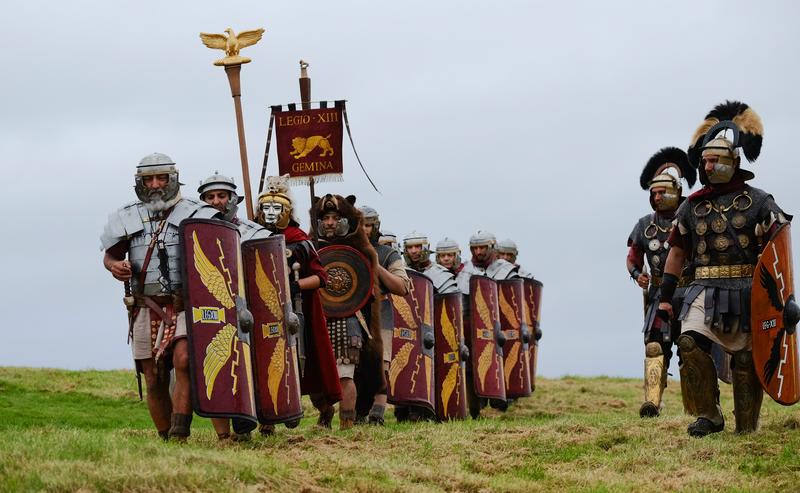How Roman Legions Worked
By | June 20, 2019

Among the great civilizations in history, the Roman Empire stands among the top for its lasting influence on Western culture. But its power was due in large part to the power of the famous Roman legions which conquered territory, ruthlessly suppressed rebellion, and built a network of roads that for the first (and arguably the only) time that linked most of Europe and the Mediterranean into a unified political unit.
So how did it work?

Size
The size of a Roman legion varied over its history. During the time of the Roman Republic (before 26 B.C.), a standard legion was considered to be about 4,000 infantry and 200 cavalries. As these numbers show, the Romans relied much more on foot soldiers than on horsemen. During emergencies, this number was raised 5,000 infantry and 300 cavalries. These figures ranged from lows of 3,000 infantry and 200 cavalries to 6,000 infantry and 400 cavalries. During the height of the Roman Empire in the second century A.D., there were roughly 25 to 30 legions throughout the Empire.

Structure
A legion headed by a legate (legatus – the equivalent of a general) and divided into ten cohorts of about 500 infantry. The first cohort was generally much larger than the other cohorts and had the most veterans in it.
The cohort was then divided into six centuriae (singular centuria) of about 80 men, each led by an officer called a centurion. Curiously, 100 men were the original size of a centuria which is why the term has the same root as century, meaning 100 years. Of these various divisions, the centuria was considered to be the most important tactical unit in a legion.
A centuria, in turn, was divided into ten conturbernia, squads of eight which was headed by the equivalent of a non-commissioned officer called a decanus. This was the most intimate unit and the men would share quarters, provisions, cooking equipment, and pack animals.
Each cohort had attached to it some cavalry and other auxiliary troops that worked war machines such as catapults, onagers, ballistas, and siege engines. Other auxiliary troops often were local tribes who attached themselves to a legion and fought as their own traditions dictated. There were also a lot of slaves who were either attached to the legion as a whole or to individual slave owners.

Armor and Weapons
Imperial legionaries tended to have standardized armor and weapons. Earlier, soldiers wore metal but this gradually was replaced by segmented plate armor. They all carried a large, rectangular shield called a scutum and two primary weapons, a six-foot javelin called the pilum and a short-double edged sword called a gladius. To protect the head, they wore a helmet called a galea. Originally leather, it was replaced by bronze and iron varieties. Officers’ helmets were surmounted by a crest of horsehair or feathers.
The pilum was generally thrown at the onset of combat in a single volley. It was designed with an iron tip, meant to penetrate an enemies shield and get stuck in it, so that it would prove cumbersome to use. The gladius was no more than 22 inches long and three inches wide. It was not a stabbing weapon, meant to eviscerate a foe as a soldier’s shield clashed tightly into an enemy line.

Discipline and Training
Roman soldiers were trained to march 20 Roman miles (18.39 modern miles) per day carrying a full load. They were repeatedly drilled in the stabbing motions of the gladius and how to throw a spear. They learned enough engineering to build roads, bridges and other infrastructure.
Discipline and punishment were severe. Rather than swearing an oath of loyalty to the country upon induction they swore to follow orders promptly and obediently. Failure to do so was was punishable by death. Another famous form of punishment was decimation, where every tenth man of a cohort would be executed by his fellows.

Tactics
The organization and structure of the legion provided it the incredible flexibility for it to defeat its foes. Various, well-organized formations were used in which well-disciplined infantry would line up in ranks. Typically after the soldiers threw the pilum they would engage in close quarters with the opponent using the gladius to stab repeatedly at the foe while covering behind their shields. When a front rank grew fatigued, the centurion called back the front rank to the rear to recuperate. These types of tactics gave the Roman army an edge of success. Its only traditional weak point was its lack of cavalry.
A great example of seeing how Roman formations worked is the battle scene in the 1960 Stanley Kubrick film Spartacus.

Logistics
Perhaps the most incredible feat of the Roman army was its logistical skills. With thousands of troops on the move, they needed food to eat, fodder for animals, and firewood to burn. To supply the troops they developed an intricate system of requisition of materials, foraging practices, and the development of a network of roads. It was only in the modern era, that the logistical abilities of the Roman army were surpassed.

Decline
The invincibility of the Roman army lasted for centuries even after it was divided into eastern and western halves in 285 A.D. While the eastern half would survive as the Byzantine Empire until 1453, the western half fell in 476 A.D. because of the rising strength of Germanic tribes, economic woes, corruption, and political instability. In fact, part of the problem was that rival claimants for the throne would use the legions to fight each other, thus weakening the entire structure. In addition, the army in its late phases started to use more and more non-Romans in its army, weakening it since they had no vested interest in the long term stability of the empire.

